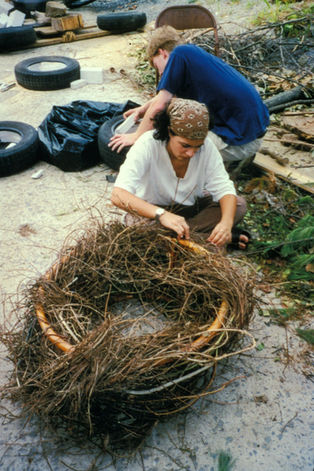
LYNNE HULL
+ MOUNTAIN LAKE WORKSHOP
Lynne Hull 1999
Internationally recognized artist from Colorado, Lynne Hull, visited southwest Virginia in 1999 to conduct a three week-long community-based collaborative Mountain Lake Workshop sponsored by Virginia Tech's Department of Art and Art History, The Wilderness Conservancy at Mountain Lake, and funds from the Virginia Commission for the Arts.. This workshop was entitled “Environmental Habitats”, and engaged students and community members in craft-oriented, discipline-centered activities (gathering specific materials and treating them, weaving, carving, preparing ground, making structures, organic flotation devices, etc.) that utilized available natural materials to create (or simulate) natural animal habitats, as well as promote a greater awareness of the sensitive conditions of the natural environment.
Ms. Hull is a sculptor and installation-artist whose work specializes in constructing site-specific habitats for wildlife, often as the result of well-organized, collaborative workshops. Her workshop in September '99 focused on the construction of six floating-habitat public "eco-sculptures" at several pond sites. The anticipated artworks are non-permanent, biodegradable structures made of local natural materials, and are intended to function as habitats for local wildlife. The art works will be temporary installations that will degrade naturally over a period of six months to a year or longer.
The workshop also included a special day of celebration at Mountain Lake to acknowledge the beauty of the native Hemlock trees - which are now mortally threatened by a nation-wide invasion of the Wooly Adelgid aphid.
Why do we Celebrate the Hemlocks?
"Hemlock Celebration" culminates three weeks of intense workshops focused on creating ecological awareness through the collaboration of art and science. During Hull's residency it became clear that Mt. Lake's pristine environment is threatened by an exotic aphid (small bug) known as the Wooly Adelgid. The wooly adelgid attaches to the underside of the hemlock needle and sucks the sap of the tree. The aphid has grown in such vast numbers that it literally sucks the life out of the tree. At Mountain Lake Lodge The sculptures and banners hanging from the hemlock tree represent local animal species that part of the special community created by the hemlock tree. The objects include birds, lizards, amphibians and insects. The blue banner and the white prayer flags hanging from the tree are illustrated with animal and plant species that also depend on Mt. Lake's unique habitat. With one look, you, the viewer becomes aware of the many lives that are affected by the changes in the lake's ecology. "Hemlock Celebration" recognizes the wonderful and longstanding life of the hemlock tree in this region. Other sites of interest Located high in an old tree standing on the edge of the lakeshore sits an owl perch and nesting platform. In Mt. Lake, a bio diversity life raft creates a sunning and nesting retention pond for amphibians, water fowl, and fish. For a limited time in the Virginia Tech Duck Pond, five habitat life rafts, created by students under Hull's direction. The life rafts will be separated and relocated by Sept 30, 1999. One will remain in duckpond while others will be relocated to the Virginia Tech landfill and other locations in Blacksburg.
"LIFE RAFTS", ECO-HABITATS, AND HEMLOCK CEREMONY








